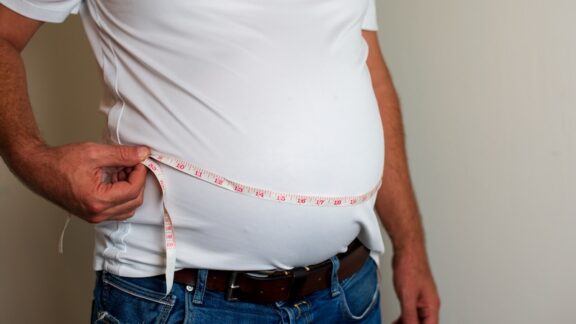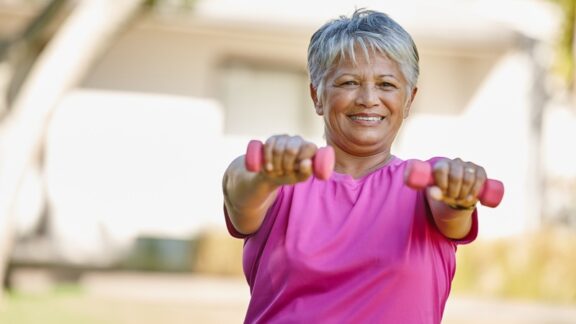After a certain age, most of us forget about looking “buff.” Men give up the dream of looking like Charles Atlas and women like their favorite celebrity. What we shouldn’t forget is that muscles are about more than sex appeal and aesthetics. They’re about more than carrying a bag of mulch or walking your 60-pound husky. Muscles help maintain stamina, health – and independence.
The bad news is that we lose muscle as we age. The good news is that you can fight age-related muscle loss!
What is age-related muscle loss and who experiences it?
Muscle mass and function naturally begin to wane when people – male and female – are in their 30s. This naturally occurring condition is called sarcopenia. If you’re inactive, you can lose as much as three to five percent of your muscle mass each decade after. Men, in fact, can lose about 30 percent of their muscle mass. Even if you’re active, some muscle loss can occur.
Why does it matter?
Muscles help us maintain the strength we need for everyday life. The National Institutes of Health notes, “Strength is commonly a factor in frailty in older patients, represented as decreased walking speed, sit-to-stand transition time, balance, stair climbing, falls, and more.”
In addition, “Less muscle means greater weakness and less mobility, both of which may increase your risk of falls and fractures,” reports Harvard Health Publishing. “A 2015 report from the American Society for Bone and Mineral Research found that people with sarcopenia had 2.3 times the risk of having a low-trauma fracture from a fall, such as a broken hip, collarbone, leg, arm, or wrist.”
How can I avoid age-related muscle loss?
Experts see two key components in maintaining muscle: exercise and diet.
Exercise
Progressive resistance training is an effective intervention for combating muscle loss and building strength. It also improves physical functioning and performance of some simple and complex activities. PRT utilizes exercise machines, free weights, and elastic bands. It gradually increases the workout volume in weight, repetitions, and number of sets.
To get started, begin with exercises that use your own body weight: squats, standing from a seated position, push-ups, etc. You can also purchase lightweight, adjustable free weights or join a gym.
Aerobic exercises such as biking, swimming, walking, and jogging can boost muscle mass, too. Plus, they have the added benefit of improving overall health, especially heart and lungs.
Building muscle is not all about strength, says Dr. Thomas W. Storer, director of the exercise physiology and physical function lab at Brigham and Women’s Hospital. You also need power. “Muscle power, how fast and efficiently you move, is more connected to the activities of daily living and physical function than muscular strength,” he says.
Storer suggests quick movements, such as rising quickly from a seated position or pushing quickly off a step. “It does not have to be every step – begin with one to three steps – but this teaches your muscles to use strength in a more effective way.”
Diet

Protein is the most important dietary element in building and maintaining muscle mass. However, as we age, the body can become less effective at breaking down and synthesizing protein. This makes protein even more important as we age.
“To build muscle, you need 0.45 gram of protein per pound of body weight,” Gary Calabrese, DPT, told Cleveland Clinic. For example, a person weighing 140 pounds should eat 63 grams of protein a day.
Beneficial protein sources come from milk, yogurt, eggs, poultry, fish, peanuts, and beans. You can also drink protein shakes and add protein powders to oatmeal, smoothies, and yogurt.
In addition to protein, you’ll need carbohydrates to fuel your workouts. Choose healthy carbohydrates such as vegetables, fruits, and whole grains rather than highly processed foods. As an added benefit, you’ll be getting other beneficial vitamins and nutrients.
To maximize muscle growth, Storer suggests having a drink or meal with a carbohydrate-to-protein ratio of three-to-one or four-to-one within 30 minutes after a workout.
“You can’t just exercise and not eat properly, and you can’t just eat properly and not exercise,” Calabrese reminds us.
Can testosterone help?
Yes, but it can have adverse effects, especially in older men, so it’s better to stick to an exercise and diet regimen.
Can I rebuild to compensate for age-related muscle loss?
Short answer: yes!
The NIH reports, “Adults between 60 and 80 years of age can experience, with appropriate training, 20 percent to 30 percent increase in aerobic fitness, similar to what people far younger achieve. … Muscle is also fully capable of responding to resistance training. For example, men over 66 years of age who trained by lifting 80 percent of their 1 RM (repetition maximum) for 12 weeks experienced strength gains of approximately 5 percent per day, which is similar to what is reported in far younger men.” One study even found significant improvements in strength and functional mobility for 90-year-olds.
So don’t forget: it’s never too late to rebuild and maintain muscle!




